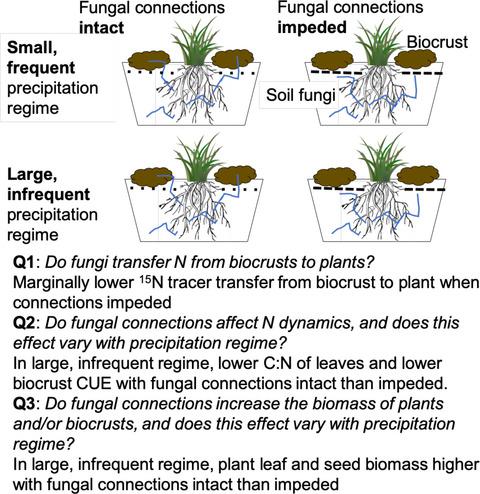Our official English website, www.x-mol.net, welcomes your feedback! (Note: you will need to create a separate account there.)
Fungal connections between plants and biocrusts facilitate plants but have little effect on biocrusts
Journal of Ecology ( IF 5.5 ) Pub Date : 2019-12-10 , DOI: 10.1111/1365-2745.13310 Eva Dettweiler‐Robinson 1 , Robert L. Sinsabaugh 1 , Jennifer A. Rudgers 1
中文翻译:

植物与生物结皮之间的真菌连接有利于植物,但对生物结皮影响不大
更新日期:2019-12-10
Journal of Ecology ( IF 5.5 ) Pub Date : 2019-12-10 , DOI: 10.1111/1365-2745.13310 Eva Dettweiler‐Robinson 1 , Robert L. Sinsabaugh 1 , Jennifer A. Rudgers 1
Affiliation

|
- Species interactions may couple the resource dynamics of different primary producers and may enhance productivity by reducing loss from the system. In low‐resource systems, this biotic control may be especially important for maintaining productivity. In drylands, the activities of vascular plants and biological soil crusts can be decoupled in space because biocrusts grow on the soil surface but plant roots are underground, and decoupled in time due to biocrusts activating with smaller precipitation events than plants. Soil fungi are hypothesized to functionally couple the plants and biocrusts by transporting nutrients. We studied whether disrupting fungi between biocrusts and plants reduces nitrogen transfer and retention and decreases primary production as predicted by the fungal loop hypothesis. Additionally, we compared varying precipitation regimes that can drive different timing and depth of biological activities.
- We used field mesocosms in which the potential for fungal connections between biocrusts and roots remained intact or were impeded by mesh. We imposed a precipitation regime of small, frequent or large, infrequent rain events. We used 15N to track fungal‐mediated nitrogen (N) transfer. We quantified microbial carbon use efficiency and plant and biocrust production and N content.
- Fungal connections with biocrusts benefitted plant biomass and nutrient retention under favourable (large, infrequent) precipitation regimes but not under stressful (small, frequent) regimes, demonstrating context dependency in the fungal loop. Translocation of a 15N tracer from biocrusts to roots was marginally lower when fungal connections were impeded than intact. Under large, infrequent rains, when fungal connections were intact, the C:N of leaves converged towards the C:N of biocrusts, suggesting higher N retention in the plant, and plant above‐ground biomass was greater relative to the fungal connections‐impeded treatment. Carbon use efficiency in both biocrust and rooting zone soil was less C‐limited when connections were intact than impeded, again only in the large, infrequent precipitation regime.
- Synthesis. Although we did not find evidence of a reciprocal transfer of C and N between plants and biocrusts, plant production was benefited by fungal connections with biocrusts under favourable conditions.
中文翻译:

植物与生物结皮之间的真菌连接有利于植物,但对生物结皮影响不大
- 物种之间的相互作用可能会耦合不同初级生产者的资源动态,并可能通过减少系统的损失来提高生产率。在资源贫乏的系统中,这种生物控制对于保持生产力特别重要。在干旱地区,维管束植物和生物性土壤结皮的活动在空间上可以解耦,因为生物结皮生长在土壤表面,而植物根系在地下,并且由于生物结皮的活化时间比植物小,因此它们可以及时解耦。假设土壤真菌通过运输养分将植物和生物结皮功能性地结合在一起。我们研究了破坏生物结皮和植物之间的真菌是否会减少真菌的循环假说所预测的氮的转移和保留并降低初级产量。此外,
- 我们使用了田间中膜,其中生物结皮和根之间的真菌连接的潜力保持不变或被网状结构阻碍。我们对小雨,频繁雨或大雨不频繁地进行了降雨。我们使用15 N来跟踪真菌介导的氮(N)的转移。我们量化了微生物碳的利用效率,植物和生物结皮的生产以及氮含量。
- 与生物结壳的真菌联系在有利的(大,不频繁)降水制度下有益于植物生物量和养分保留,但在压力(小,频繁)制度下却没有,表明了真菌环中的环境依赖性。当真菌连接受到阻碍时,从生物结皮到根的15 N示踪剂的转运比完好无损。在不经常发生的大雨下,当真菌连接完好无损时,叶片的C:N趋向于生物结皮的C:N,表明植物中的氮保留量更高,并且相对于真菌连接,植物的地上生物量更大。治疗。当连接完好时,生物结皮和生根带土壤中的碳利用效率均受到限制,其碳限制效率较低,这同样仅在不经常发生的大降水条件下有效。
- 综合。尽管我们没有发现植物和生物结皮之间碳和氮相互转移的证据,但在有利的条件下,真菌与生物结皮的连接使植物的生产受益。



























 京公网安备 11010802027423号
京公网安备 11010802027423号